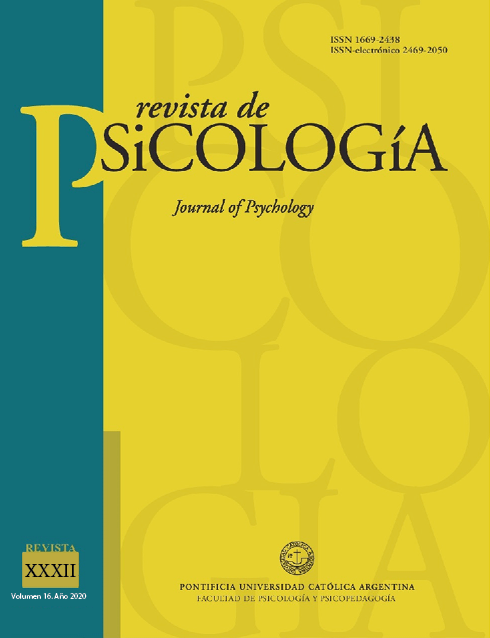Adaptation and validation of the Vienna art interest and art knowledge questionnaire (VAIAK)
DOI:
https://doi.org/10.46553/RPSI.16.32.2020.p68-78Keywords:
Visual arts, Prior knowledge, InterestAbstract
Expertise proved to be a relevant variable when it came to study visual art reception processes. The Vienna Art Interest and Art Knowledge Questionnaire was conceived as an unified and validated measure of expertise using a psychometric focus. The objective of this study was to translate, adapt and validate the questionnaire for use in research with the Argentine population. 153 students voluntarily completed the questionnaire as a group or individually. Analysis of internal consistency, construct validity through factor analysis, and discriminant validity were performed through comparisons between psychology and art history students, as well as correlation of measures. Evidence was obtained of the reliability and validity of the Interest scales, and of an adapted part of the Knowledge scale.
Downloads
References
Afhami, R., & Mohammadi-Zarghan, S. (2018). The Big Five, aesthetic judgement styles, and art interest. Europe’s Journal of Psychology, 14(4), 764. https://dx.doi.org/10.5964%2Fejop.v14i4.1479.
Arnheim, R. (1965). Art and visual perception: A psychology of the creative eye. Berkeley, CA: Univ of California Press.
Belke, B., Leder, H., & Augustin, D. (2006). Mastering style. Effects of explicit style-related information, art knowledge and affective state on appreciation of abstract paintings. Psychology Science, 48(2), 115. Recuperado de https://psycnet.apa.org/record/2006-10718-003.
Bullot, N. J., & Reber, R. (2013). The artful mind meets art history: Toward a psycho-historical framework for the science of art appreciation. Behavioral and Brain Sciences, 36(2), 123-137. https://doi.org/10.1017/S0140525X12000489.
Chamorro-Premuzic, T., & Furnham, A. (2008). Personality, intelligence and approaches to learning as predictors of academic performance. Personality and Individual Differences, 44(7), 1596-1603. https://doi.org/10.1016/j.paid.2008.01.003.
Fancourt, D., & Finn, S. (2019). What is the evidence on the role of the arts in improving health and well-being?. Copenhagen: WHO Regional Office for Europe.
Fechner, G. T. (1876). Vorschule der ästhetik. Leipzig: Breitkopf & Härtel.
Gartus, A., Klemer, N., & Leder, H. (2015). The effects of visual context and individual differences on perception and evaluation of modern art and graffiti art. Acta Psychologica, 156, 64-76. https://doi.org/10.1016/j.actpsy.2015.01.005.
Hu, L. T., & Bentler, P. M. (1999). Cutoff criteria for fit indexes in covariance structure analysis: Conventional criteria versus new alternatives. Structural Equation Modeling: A Multidisciplinary Journal, 6(1), 1-55. https://doi.org/10.1080/10705519909540118.
Koida, N., Kubo, T., Nishida, S., Shibata, T., & Ikeda, K. (2015). Art expertise reduces influence of visual salience on fixation in viewing abstract paintings. PloS One, 10,
e0117696. https://doi.org/10.1371/journal.pone.0117696.
Kou, X., Konrath, S., & Goldstein, T. R. (2019). The relationship among different types of arts engagement, empathy, and prosocial behavior. Psychology of Aesthetics, Creativity, and the Arts. Advance online publication. https://doi.org/10.1037/aca0000269.
Lin, F., & Yao, M. (2018). The impact of accompanying text on visual processing and hedonic evaluation of art. Empirical Studies of the Arts, 36(2), 180-198. https://doi.org/10.1177/0276237417719637.
Meskin, A., Robson, J., Ichino, A., Goffin, K., & Monseré, A. (2018). Philosophical aesthetics and cognitive science. Wiley Interdisciplinary Reviews: Cognitive Science, 9(1), e1445. https://doi.org/10.1002/wcs.1445.
Ortlieb, S. A., & Carbon, C. C. (2019). Kitsch and perception: towards a new ‘aesthetic from below’. Art & Perception, 7(1), 1-26. https://doi.org/10.1163/22134913-00001091.
Panofsky, E. (1972). Studies in iconology: Humanistic themes in the art of the Renaissance. New York, NY: Harper & Row.
Pelowski, M., Cabbai, G., Brinkmann, H., Mikuni, J., Hegelmaier, L. M., Forster, M., Rosenberg, R., & Leder, H. (2020). The kitsch switch—or (when) do experts dislike Thomas Kinkade art? A study of time-based evaluation changes in top-down versus bottom-up assessment. Psychology of Aesthetics, Creativity, and the Arts. Advance online publication. https://doi.org/10.1037/aca0000302.
Pelowski, M., Markey, P. S., Forster, M., Gerger, G., & Leder, H. (2017). Move me atonish me… delight my eyes and brain: The Vienna integrated model of top-down and bottom-up processes in art perception (VIMAP) and corresponding affective, evaluative, and neurophysiological correlates. Physics of Life Reviews, 21, 80-125. https://doi.org/10.1016/j.plrev.2017.02.003.
Pelowski, M., Markey, P. S., Lauring, J. O., & Leder, H. (2016). Visualizing the impact of art: An update and comparison of current psychological models of art experience. Frontiers in human neuroscience, 10, 160. https://doi.org/10.3389/fnhum.2016.00160.
R Core Team (2019). R: A language and environment for statistical computing. R Foundation for Statistical Computing, Vienna, Austria. Available online at https://www.R-project.org/
Revelle, W. (2018) psych: Procedures for Personality and Psychological Research, Northwestern University, Evanston, Illinois, USA, https://CRAN.R-project.org/package=psych Version = 1.8.12.
Smith, L. F., & Smith, J. K. (2006). The nature and growth of aesthetic fluency. In P. Locher, C. Martindale, & L. Dorfman (Eds.), Foundations and Frontiers in Aesthetics. New directions in aesthetics, creativity and the arts (p. 47–58). Amityville, NY: Baywood.
Specker, E., Forster, M., Brinkmann, H., Boddy, J., Pelowski, M., Rosenberg, R., & Leder, H. (2018). The Vienna Art Interest and Art Knowledge Questionnaire (VAIAK): A unified and validated measure of art interest and art knowledge. Psychology of Aesthetics, Creativity, and the Arts. Advance online publication. https://doi.org/10.1037/aca0000205.
Stangos, N. (2000). Conceptos del arte moderno: del fauvismo al posmodernismo. Barcelona: Destino.
Rosseel, Y. (2012). lavaan: An R Package for Structural Equation Modeling. Journal of Statistical Software, 48(2), 1-36. http://dx.doi.org/10.18637/jss.v048.i02.
van Paasschen, J., Bacci, F., & Melcher, D. (2015). The influence of art expertise and training on emotion and preference rating for representational and abstract artworks. PLoS One, 10(8): e0134241. https://dx.doi.org/10.1371%2Fjournal.pone.0134241.
Vogt, S., & Magnussen, S. (2007). Expertise in pictorial perception: eye-movement patterns and visual memory in artists and laymen. Perception, 36(1), 91-100. https://doi.org/10.1068/p5262.
Downloads
Published
How to Cite
Issue
Section
License



















